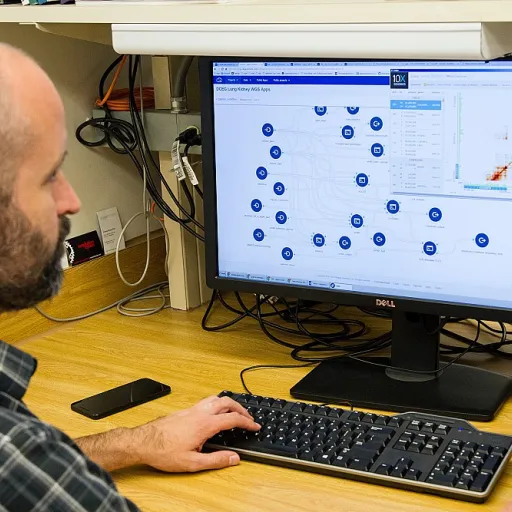
Understanding Hawaii's IT Security Landscape
Exploring Hawaii's Unique IT Security Environment
Hawaii's IT security landscape is shaped by a combination of state-specific regulations and broader federal requirements. The state's geographical isolation and unique economic structure, heavily reliant on tourism and military presence, create distinct challenges and opportunities for businesses operating here. Understanding these nuances is crucial for organizations aiming to achieve compliance and protect their data effectively.
Key Factors Influencing IT Security
Several factors contribute to the complexity of Hawaii's IT security environment:
- Geographical Isolation: Hawaii's location presents unique challenges in terms of network access and data transfer, necessitating robust security controls to prevent data breaches.
- Military Presence: With a significant number of DoD contractors operating in Hawaii, compliance with standards like CMMC (Cybersecurity Maturity Model Certification) is critical. This ensures that sensitive defense-related data remains secure.
- Tourism Industry: The high volume of personal data handled by the tourism sector underscores the importance of stringent data privacy and security policies.
Regulatory Framework and Compliance Requirements
Hawaii's IT security regulations are influenced by both state laws and federal mandates. Key compliance standards include:
- Data Privacy Laws: These laws govern how businesses collect, store, and use personal data, emphasizing the need for strong data governance practices.
- PCI DSS: Payment Card Industry Data Security Standard compliance is essential for businesses handling credit card transactions, ensuring data security and breach prevention.
- Breach Notification Requirements: Companies must have an incident response plan to notify affected parties promptly in the event of a data breach.
For businesses in Hawaii, navigating these requirements involves a comprehensive assessment of their current security systems and practices. Implementing best practices in cybersecurity maturity and access control can significantly enhance their compliance posture.
For more insights into how advanced IT services can enhance your business operations, explore our detailed analysis on enhancing accounting firms with advanced IT services.
Key Compliance Standards and Regulations
Essential Compliance Standards in Hawaii
In Hawaii, navigating the complex landscape of IT security compliance requires a comprehensive understanding of various standards and regulations. These frameworks are designed to safeguard data privacy and ensure robust cybersecurity practices across industries. Here, we delve into some of the key compliance standards that businesses must adhere to.
Federal and State Regulations
Hawaii businesses, especially those dealing with sensitive information, must comply with both federal and state regulations. The Cybersecurity Maturity Model Certification (CMMC) is crucial for Department of Defense (DoD) contractors, ensuring that they meet stringent cybersecurity requirements. This certification is part of a broader effort to protect the supply chain from data breaches and unauthorized access.
On a state level, Hawaii enforces privacy laws that mandate businesses to implement effective data security measures. These laws require organizations to have a clear data governance strategy and a robust incident response plan to handle potential breaches.
Industry-Specific Standards
Different industries in Hawaii are subject to specific compliance standards. For instance, businesses handling payment card information must adhere to the Payment Card Industry Data Security Standard (PCI DSS). This standard emphasizes the importance of access control, network security, and breach notification protocols to protect consumer data.
Healthcare providers are required to comply with the Health Insurance Portability and Accountability Act (HIPAA), which focuses on safeguarding patient data privacy and security. These regulations highlight the necessity for a comprehensive security policy and regular security assessments.
Best Practices for Compliance
To effectively meet these compliance requirements, businesses should adopt best practices such as conducting regular security assessments and maintaining a dynamic security policy. Implementing a cybersecurity maturity model can help organizations systematically improve their security posture over time.
For more insights on how emerging technologies are influencing compliance, explore our article on how AI is revolutionizing cybersecurity.
Impact on Software Development Practices
Influence of Compliance Standards on Software Development
In Hawaii, the intricate web of IT security compliance requirements significantly shapes software development practices. Developers must navigate a landscape where data privacy and security are paramount, influenced by a variety of standards and regulations. These include the Cybersecurity Maturity Model Certification (CMMC), which is particularly crucial for Department of Defense (DoD) contractors, and the Payment Card Industry Data Security Standard (PCI DSS), among others.
To align with these compliance requirements, software development teams must integrate robust security controls and data governance frameworks into their processes. This involves conducting regular security assessments and ensuring that access control mechanisms are in place to protect sensitive data from unauthorized access. The emphasis on data privacy and breach notification laws means that developers must also prioritize incident response strategies to mitigate potential data breaches effectively.
Adapting to Compliance-Driven Development Practices
Compliance standards necessitate a shift in how software is developed, with a focus on embedding security into every stage of the software development lifecycle. This approach, often referred to as 'security by design,' ensures that privacy and security considerations are not afterthoughts but integral components of the development process. By adopting best practices in security policy and data privacy, developers can create systems that are resilient to cyber threats and compliant with Hawaii's privacy laws.
Moreover, the maturity model certification programs, such as CMMC compliance, require developers to demonstrate a certain level of cybersecurity maturity. This involves not only implementing technical safeguards but also fostering a culture of security awareness within development teams. By doing so, organizations can enhance their security posture and meet the stringent requirements set forth by compliance standards.
For businesses operating in Hawaii, understanding the impact of compliance on software development is crucial. By staying informed about the latest developments in IT security compliance, companies can ensure that their software solutions are not only secure but also compliant with the relevant laws and regulations. For more insights into how emerging technologies are shaping software development practices, explore the leading AI-driven cloud platforms for business management.
Emerging Technologies and Compliance
Integrating New Technologies with Compliance
The rapid evolution of technology presents both challenges and opportunities for IT security compliance in Hawaii. As businesses strive to meet compliance requirements, they must also adapt to emerging technologies that can enhance their security posture. This section explores how these technologies are shaping compliance efforts.
Adopting Cloud-Based Solutions
Cloud-based solutions offer flexibility and scalability, which are crucial for businesses aiming to maintain compliance with Hawaii's privacy laws and security standards. By leveraging cloud technology, companies can implement robust security controls and data governance frameworks that align with compliance requirements. However, they must ensure that their cloud providers adhere to the same standards, particularly concerning data privacy and breach notification protocols.
Embracing AI and Machine Learning
Artificial intelligence (AI) and machine learning are becoming integral to cybersecurity strategies. These technologies can enhance threat detection and incident response capabilities, allowing businesses to proactively manage risks and comply with data security regulations. AI-driven systems can automate compliance assessments, providing real-time insights into potential vulnerabilities and ensuring that security policies are consistently enforced across the network.
Implementing Advanced Access Control Systems
Access control is a key component of any security program, and advancements in this area are critical for compliance. Modern access control systems utilize biometric authentication and multi-factor authentication to secure sensitive data and prevent unauthorized access. These systems are essential for meeting compliance standards such as the Cybersecurity Maturity Model Certification (CMMC) and PCI DSS, which require stringent access management practices.
Enhancing Supply Chain Security
With the increasing complexity of supply chains, businesses must ensure that their contractors and partners comply with security and privacy laws. Implementing a comprehensive supply chain security policy can help organizations manage third-party risks and maintain compliance. This involves conducting regular assessments and ensuring that all parties adhere to the same cybersecurity maturity model and certification standards.
Opportunities for DoD Contractors
For Department of Defense (DoD) contractors in Hawaii, staying ahead of compliance requirements is crucial. By integrating emerging technologies into their operations, these contractors can enhance their cybersecurity posture and meet the stringent requirements of CMMC compliance. This not only protects sensitive data but also positions them as leaders in the field of cybersecurity.
Challenges and Opportunities for Businesses
Balancing Compliance and Innovation
Businesses in Hawaii face a unique set of challenges and opportunities when it comes to IT security compliance. The state's specific privacy laws and regulations require organizations to be vigilant about data security and privacy. This means implementing robust security controls and maintaining a comprehensive security policy to prevent data breaches and ensure compliance with key standards like PCI DSS and CMMC.
Challenges in Meeting Compliance Requirements
One of the primary challenges is the complexity of compliance requirements. Companies must navigate a myriad of laws and regulations, including those set by the Department of Defense (DoD) for contractors. This involves achieving CMMC compliance, which requires a thorough assessment of cybersecurity maturity and the implementation of a maturity model certification. Additionally, businesses must ensure that their supply chain partners adhere to the same standards, adding another layer of complexity.
Data governance is another critical area. Organizations must establish clear policies for data access and privacy, ensuring that sensitive information is protected at all times. This includes implementing access control measures and having a robust incident response plan in place to handle any data breaches effectively.
Opportunities for Growth and Improvement
Despite these challenges, there are significant opportunities for businesses to improve their cybersecurity posture. By adopting best practices and leveraging emerging technologies, companies can enhance their security programs and reduce the risk of data breaches. This not only helps in meeting compliance requirements but also builds trust with customers and partners.
Furthermore, the focus on cybersecurity and data privacy can drive innovation within organizations. By investing in advanced security systems and training programs, businesses can stay ahead of the curve and adapt to the evolving threat landscape. This proactive approach not only ensures compliance but also positions companies as leaders in the field of cybersecurity.
Future Trends in IT Security Compliance
Anticipating Future Compliance Trends
As we look to the future of IT security compliance in Hawaii, several trends are poised to shape the landscape. These trends will not only influence how businesses operate but also how they approach data security and privacy. Understanding these trends is crucial for organizations aiming to stay ahead in a rapidly evolving environment.
Increased Focus on Data Privacy
With the growing emphasis on data privacy, businesses in Hawaii must prepare for stricter privacy laws and regulations. The implementation of comprehensive data privacy frameworks will become essential. Organizations will need to enhance their data governance strategies to ensure compliance with evolving privacy requirements. This will involve adopting robust data security measures and implementing effective breach notification systems to protect sensitive information.
Advancements in Cybersecurity Maturity Models
The Cybersecurity Maturity Model Certification (CMMC) is expected to undergo significant advancements. As the Department of Defense (DoD) continues to refine its requirements, contractors will need to adapt to new certification standards. This will necessitate regular assessments and updates to security policies to maintain compliance. Businesses will need to invest in cybersecurity maturity programs to meet the evolving demands of the DoD and other regulatory bodies.
Integration of Emerging Technologies
Emerging technologies such as artificial intelligence and blockchain are set to play a pivotal role in IT security compliance. These technologies offer innovative solutions for enhancing security controls and improving access control mechanisms. By leveraging these advancements, businesses can strengthen their cybersecurity posture and streamline compliance processes. However, integrating these technologies will require careful consideration of potential risks and challenges.
Opportunities for Collaboration and Innovation
The future of IT security compliance in Hawaii presents numerous opportunities for collaboration and innovation. Businesses can benefit from sharing best practices and insights to address common challenges. Collaborative efforts can lead to the development of more effective security programs and systems. Additionally, innovation in compliance solutions will drive the creation of new tools and technologies to support businesses in meeting their compliance objectives.
In conclusion, staying informed about future trends in IT security compliance is essential for businesses in Hawaii. By proactively addressing these trends, organizations can navigate the complexities of compliance and safeguard their data and networks effectively.















